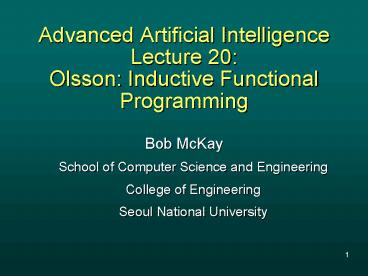Advanced Artificial Intelligence Lecture 20: Olsson: Inductive Functional Programming PowerPoint PPT Presentation
1 / 22
Title: Advanced Artificial Intelligence Lecture 20: Olsson: Inductive Functional Programming
1
Advanced Artificial IntelligenceLecture 20
Olsson Inductive FunctionalProgramming
- Bob McKay
- School of Computer Science and Engineering
- College of Engineering
- Seoul National University
2
Outline
- ADATE Program synthesis system
3
Roland Olsson
- Inductive Functional Programming using
Incremental Program Transformation - Artificial Intelligence 74 (1995), 55-81
- Actually, just one of a series of papers on
program transformation and program learning - System called ADATE
- Automatic Design of Algorithms Through Evolution
- Despite the name, not an evolutionary algorithm
- _very_ deterministic search methods
- Many versions
4
Inductive Functional Programming
- Representation
- Clean fragment of a standard functional
programming language - Standard ML
- Search
- Deterministic
- Iterative deepening
- Operators
- The main focus of Olssons work
5
Problem Specification
- A critique of ILP-style approaches
- Problem specification as set of input/output
pairs - Correct or incorrect
- Input/output pairs
- Usually only one output per input
- A functional, rather than relational,
specification - Unfairly biases search
- Argues for real-valued evaluations (not just 0/1)
- Similar to GP fitness functions
- Interesting because of time
- PhD 1994 - early GP
- More based on ILP than GP
6
Program Evaluation (Fitness) Function
- Components of Fitness
- Syntactic complexity
- Let mi be the number of alternatives at node i of
expression tree - S ?i log mi (that is, total information
content) - T - Time complexity
- Nc - Number of Correct Outputs
- Note programs may give dont know outputs
- Nw - Number of Wrong Outputs
- Overall fitness functions difficult to understand
7
Language
- Standard ML with omissions
- Currying
- write f(x,y) rather than (f(x))(y)
- Boolean operators
- If expressions
- References
8
Transformations Abstraction
- Given a subexpression
- H(E1,, En)
- In a program, replace it with
- Let fun f(V1,, Vn) H(V1,, Vn) in g(E1,, En)
end - That is, introduce a new function definition
equal to that subexpression
9
Transformations Case Distribution
- Case distribution distributes function
applications over cases - If we have
- h(A1,,Ai, case E of Match1 gt E1
Matchn gt En Ai2,,Am) - Replace it with
- case E of Match1 gt h(A1,,Ai, E1, Ai2,,Am)
Matchn gt h(A1,,Ai, En, Ai2,,Am) - Or vice-versa
- That is, the transformation can be used in either
direction
10
Transformations Embedding
- Given a let definition
- Let fun f(V1,, Vn) RHS in Exp end
- Embedding replaces the type expression for one of
the Vi with a compound type (list, tree or
similar) - This means that the types in RHS and Exp must
change also - There are further special restrictions to ensure
consistency and avoid potentially long (or even
infinite) recursions of type replacement
11
TransformationsExpression Synthesis
- ADATE synthesises all epxressions of depth 1,
then of depth 2,. - It uses heuristics to prune the search space of
all possible syntheses - For synthesised case-expressions, before fully
synthesising, ADATE executes the partial program
to test that more than one case is activated if
not, the case is omitted - For synthesised recursions, ADATE uses a partial
ordering on expressions to ensure that the RHS
case is in some sense simpler than that on the LHS
12
Compound Transformations
- ADATE synthesises programs starting with a
trivial program and applying sequences of
transformations - A compound transformation
- The sequence of transformations is highly
restricted - Only particular transformations may come after
others
13
ADATE search
- ADATE search is a complex deterministic search
method - It searches by smallest number of case
expressions - For a given number of case expressions, it
maintains three programs, the best so far using
each of three fitness measures, which favour - Correctness
- Size
- Time complexity
14
Analysis of Recursion
- Interesting point that recursion generally
requires coupled development of two expressions - General case
- Terminating case
- Fitness only improves if they are properly linked
- Difficult for GP to do
- Not explainable by schema theory
15
Analysis of Recursion
- Possible ways of overcoming this
- Add operators that couple changes to recursive
case and terminating case - Change representation so that recursive case and
terminating case are linked
16
ADATE More Recent Work
- Population Management for Automatic Design of
Algorithms through Evolution (1998) - Despite the title, deterministic search
- But discusses some issues of population control
- Relevant to beam search as well as to
evolutionary search
17
ADATE More Recent Work
- How to invent functions (1999)
- More detailed study of abstraction
- Especially examination of heuristics for choosing
suitable abstractions - Argues that ADATE is a form of evolutionary
computation, though not stochastic - Im not sure that this is a useful categorisation
18
ADATE More Recent Work
- Self-Improvement for the ADATE Automatic
Programming System (2002) - Uses ADATE to generate transformations of its own
search space - Does not result in significant improvement
19
ADATE Evaluation
- Interesting performance
- Generally comparable with complexity of ILP
programs - Seems to handle recursion well
- Some very tough problems solved
- Binary Search Tree deletion, insertion
- Deterministic search
- But very complex
- Can be considered a form of tightly-controlled
beam-search
20
ADATE Evaluation
- Results were highly impressive for 1995
- There doesnt seem to have been much progress
since - Not clear that this is a productive research
direction - But transformations may be useful in more
stochastic searches
21
Summary
- ADATE
- Deterministic algorithm
- Complex beam search
- Shares many characteristics with evolutionary
search - But not stochasticity
22
?????

